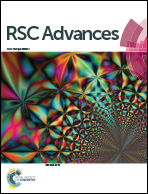Hydrothermal synthesis and formation mechanism of the anatase nanocrystals with co-exposed high-energy {001}, {010} and [111]-facets for enhanced photocatalytic performance†
Abstract
Truncated tetragonal bipyramid anatase TiO2 nanocrystals enclosed by {001}, {010} and {101} facets, and tetragonal cuboid anatase TiO2 nanocrystals with co-exposed [111]- and {101} facets were hydrothermally synthesized by using the H+-form of the tetratitanate H2Ti4O9 as the precursor and HF and H2O2 as the capping agent and solvent, respectively. The as-prepared anatase TiO2 nanocrystals were characterized by X-ray diffraction (XRD), scanning electron microscopy (SEM), transmission electron microscopy (TEM) and high-resolution transmission electron microscopy (HRTEM), selected-area electron diffraction (SAED) and nitrogen adsorption/desorption measurements. The transformation from the layered structure of tetratitanate HTO to anatase TiO2 nanocrystals may experience two types of reactions including in situ topotactic transformation reaction by splitting the Ti–O–Ti bonds of the corner-shared by two TiO6 octahedra along the [010]-direction of the HTO, and the dissolution–recrystallisation reaction along various crystal planes of the zigzag ribbon-like anatase crystal during the hydrothermal reaction process. Furthermore, the photocatalytic activities of the as-prepared anatase nanocrystals were evaluated by the photocatalytic degradation of methylene blue under UV-light irradiation at room temperature in air. Truncated tetragonal bipyramid and cuboid coexistence of anatase TiO2 nanocrystals with a large percentage of co-exposed high-energy {001}, {010} and [111]-facets exhibit high surface photocatalytic activities for the degradation amount of MB per unit surface area of catalyst (mg (MB) per m2 (TiO2 surface area)), which can be explained by the cooperative mechanism of the surface atomic structure and surface electronic structure of the different facets.
![Graphical abstract: Hydrothermal synthesis and formation mechanism of the anatase nanocrystals with co-exposed high-energy {001}, {010} and [111]-facets for enhanced photocatalytic performance](/en/Image/Get?imageInfo.ImageType=GA&imageInfo.ImageIdentifier.ManuscriptID=C7RA03707D&imageInfo.ImageIdentifier.Year=2017)


 Please wait while we load your content...
Please wait while we load your content...